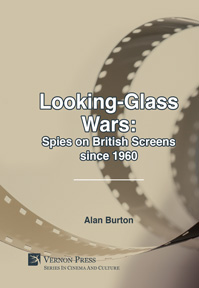Directing the Narrative and Shot Design
The Art and Craft of Directing
by Lubomir Kocka (Savannah College of Art and Design)
Purchase this book
(click here to change currency)
“The book is written with commendable clarity, dealing with the conceptual side of the film directing. Skilled artistry and a high level of craftsmanship results in a high-quality product. And that’s the premise of this book. This book will equip the readers with the necessary knowledge and practical experience, ensuring they are highly qualified and capable for any director’s position.”
Milos Forman, Film director, screenwriter, and professor. One Flew Over the Cuckoo's Nest (1975), Amadeus (1984), The People vs. Larry Flynt (1996). His films have been nominated for a total of 33 Academy Awards, with 13 wins including the coveted Best Director and Best Picture awards.
“Lubomir Kocka shares his encyclopedic technical expertise as well as the invaluable wisdom of an industry veteran with infectious passion. This comprehensive guide combines clear, practical advice with brilliant insights to enable everyone - from the novice to the working professional - to create compelling cinema. With great clarity, Kocka demystifies the art of filmmaking and reveals the ways in which we can powerfully express ourselves and connect with others through this magical medium.”
Geoffrey Fletcher, Film director, professor, screenwriter of Precious, the winner of the Best Adapted Screenplay Oscar in 2010.
“This is the epitome of guidance for any director, beginner or professional. The information is very detailed and informative. All directors would benefit from this book.”
Stratton Leopold, Producer of major, large-budget motion pictures. The Wolfman (2010), Mission: Impossible III (2006), The General's Daughter (1999).
“Professor Kocka has managed something I wouldn’t have thought possible. He has created a technical book with impeccable scholarship. One of the many remarkable aspects is that the content is so nuanced and layered, it is accessible to beginner film students while at the same time revealing more in-depth issues to the experienced director with each subsequent reading. Cinematographers and production designers will also find this book to be a fountain of useful knowledge. This book is a must buy for any filmmaker whether they are aspirational or well-seasoned.”
Michael Nolin, Film professor, motion picture producer, writer/director. Selected producing credits include Mr. Holland's Opus (1995).
This book is a “directing-altering book” as it provides high-quality learning resources that encourage and challenge film enthusiasts, aspiring directors, film students, and professionals to strive for new levels of excellence and impact in their film directing, television directing, and new media directing.
This book puts forward a well-informed and innovative discussion of critical director’s choices that have not previously been considered by existing texts on film and television directing. This book presents a wide range of directorial concepts and directing exercises that include:
• Psycho-physiological regularities in left-right/right-left orientation transferred to a shot design. How directors can manipulate the viewer’s perception of a character and of the journey they are on using screen direction.
• Methodology and visual strategy for rendering a scene based on character perspective.
• The directorial concept of emotional manipulation.
• Demystifying the 180-degree rule.
PREFACE
PART I: DIRECTORIAL CONCEPTS
CHAPTER 1: DIRECTOR
CHAPTER 2: VISUAL CONCEPT
CHAPTER 3: CONCEPT OF VISUAL UNITS
CHAPTER 4: MANIPULATING FILM TIME
CHAPTER 5: CONTROLLING SPACE
CHAPTER 6: BLOCKING STRATEGIES
CHAPTER 7: MULTIPLE-CHARACTER SCENE
CHAPTER 8: DEMYSTIFYING THE 180-DEGREE RULE
– CROSSING THE LINE
CHAPTER 9: CONCEPT OF CHARACTER PERSPECTIVE
CHAPTER 10: CONCEPT OF STORYTELLER’S PERSPECTIVE
CHAPTER 11: EMOTIONAL MANIPULATION/
EMOTIONAL DESIGN
CHAPTER 12: PSYCHO-PHYSIOLOGICAL REGULARITIES
IN LEFT-RIGHT/RIGHT-LEFT ORIENTATION
CHAPTER 13: DIRECTORIAL-DRAMATURGICAL ANALYSIS
CHAPTER 14: DIRECTOR’S BOOK
CHAPTER 15: PREVISUALIZATION
PART II: STUDIOS – DIRECTING EXERCISES
CHAPTER 16: I. STUDIO – APPLICATION
OF GENRE CONVENTIONS
CHAPTER 17: II. STUDIO – BLOCKING IN DEPTH
CHAPTER 18: III. STUDIO – BLOCKING
IN 360-DEGREE SPACE
CHAPTER 19: IV. STUDIO – MODELING
CHARACTER PERSPECTIVE
CHAPTER 20: V. STUDIO - ALTERNATION
IN STORYTELLER’S PERSPECTIVE
CHAPTER 21: VI. STUDIO -
EXTERNALIZING/PHYSICALIZING
INNER STATE OF MIND OF THE
CHARACTER
CHAPTER 22: VII. STUDIO - HARMONIOUS PORTRAIT
AND DISCORDANT PORTRAIT
PART III: VIDEO ASSIGNMENTS
CHAPTER 23: SELF-PORTRAIT
CHAPTER 24: VIDEO-STUDY OF CHARACTER
CHAPTER 25: VIDEO-STUDY OF PLACE
CHAPTER 26: PHOTOSCRIPT
CHAPTER 27: VIDEO-STORYBOARD ONE SCENE
- TWO WAYS OF APPROACHING
CHAPTER 28: SHORT LIVE ACTION NARRATIVE FILM
PART IV: STUDIO SCRIPTS
PART V: QUIZ, TESTS, CHARTS, TEMPLATES
EPILOGUE
PHOTO ALBUM
ABOUT THE AUTHOR
INDEX
Lubomir Kocka is a director, screenwriter, producer, and professor. He has directed nine feature films, thirteen television dramas, and seven TV series and miniseries. He has won numerous awards from international film and television festivals around the world. In addition to his numerous directing and writing credits, he is also an acclaimed film educator. Currently, he is based in Savannah, Georgia, USA, at the Savannah College of Art and Design (SCAD) as a Professor of Film and Television, where he has taught since 2002.
Psycho-physiological regularities in left-right / right-left orientation, Concept of Character perspective, Visual Look, Film Genre, Visual Structure, Directing Style, Flat Space, Staging on line, Deep Space, Staging in depth, Blocking On the line, Blocking In-depth, Shot-reverse shot Pattern, Approaching and Receding Pattern, Integral shot, Blocking in 360-degree space, Multiple-Charcter scene, Crossing the line, Screen Time, Frame Composition, Physical Size, Depth of Field, Camera Movement, Lines, Lenses, Visual Weight, Psychological Weight, Storytellers Perspective, OTS Shot, POV shot, Rhythm, Editing, Time, Lighting, Color, Distorted Image, Costume, Director’s Choices, Shift in a Character Perspective, Emotional manipulation, Emotional stimuli, Emotional engagement, Emotional response, Protagonist vs. Antagonist, Dominant vs. Submissive, Sympathetic vs. Unsympathetic, Directionality of movement, Pursuing goals and objectives, Returning home, History of the story, Future of the story, Character contemplates the past, Character contemplates the future, Directorial-Dramaturgical Analysis, Director’s Book, Previsualization, photoscrip, Video-Storyboard, emotional beats, Associative point, emotional focus of a scene, Physicalizing and externalizing emotions, reminiscences of a character, narrator’s attitudinal point of view, Subjective manner of Treatment, emotional transition, character’s transformation, inner state of mind of characters, psychological state of the character, style-consistency film, directing actors, cinematography, shot design, art direction, harmonious portrait of situation, discordant portrait of situation, Short Live Action Narrative Film, Video-Study of Character, Video-Study of Place,books about directing, film and television directing, directing director, cinema, television, film-making, motion picture, film studies
Subjects
Art
Series
Series in Cinema and Culture
Related services
Find in a library near you Download print-friendly flyer Download HQ cover Find in Bookshop.org Find this title in AmazonSee also
Bibliographic Information
Book Title
Directing the Narrative and Shot Design
Book Subtitle
The Art and Craft of Directing
ISBN
978-1-62273-399-6
Edition
1st
Number of pages
446
Physical size
236mmx160mm

![Directing the Narrative and Shot Design [Hardback, B&W]](/file/5663/441c7be8853b7c63c57d8f65c3b7e1d9/1522756778.jpg)





